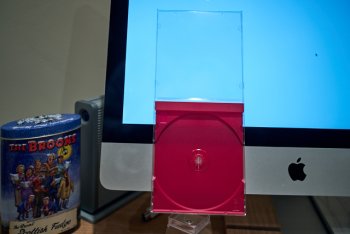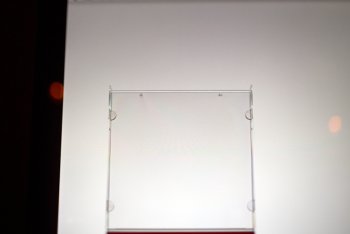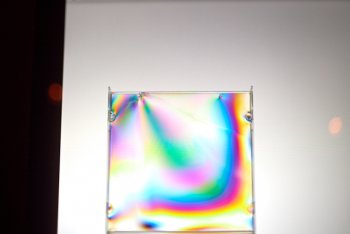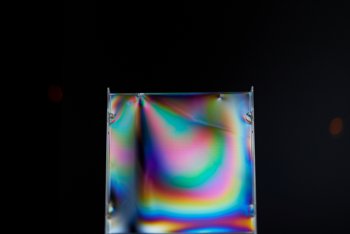After another rainy day, I looked to explore the phenomenon of optical birefringence.
This effect occurs when polarised light passes through certain transparent objects that contains a range of molecular alignments. Changes in molecular alignment and small differences in thickness result in the polarised light taking different times to pass through the object. When these 'rays' of light exit the object, they cause an interference pattern that can be seen as a rainbow effect. This is similar to the effect we say with the light being reflected from the surfaces of the bubble film in the Soap Bubble Macro project.
Enough science - how do we do it?
1. What we need:
A source of polarised light. You can buy sheets of polaroid film to place in front of any light source but unless you have it to hand then you have to order online. You could use the lens from a pair of polaroid sunglasses but this makes your light source small. A convenient polarised light source is an LED computer display (eg iMac or iPad but brand is not important).
You also need a polarising filter for the front of your lens. Most landscape photographers, myself included, use a polarising filter to reduce glare and increase saturation in landscape photos. Again, like the source, you could use a lens from a polaroid sunglass but this is not convenient (see later).
Something transparent. Many crystals and plastic objects work well but part of the fun is to explore what works.
2. How-To:
(a) Place the test object (in this example a CD case) in front of your polarised light source:

(note: the tin of The Broons Scottish Fudge is optional)

(focussed-in on the transparent part of the CD case)
(b) Then attach the polariser filter to the front of your lens:

As if by magic, rainbow colours appear.
(c) Rotate the polariser on the front of the lens and watch the light-source go black indicating full cross-polarisation:

Colours begin to pop!
3. Post processing
Very little or no work needed to get the final image - perhaps darken the blacks a fraction and brighten the mid-tones as we did with the bubbles.
4. What to use?
Have fun experimenting with what works and what doesn't. Here is a bit of food packaging as you've never seen it:

Many thin, blow-moulded plastic objects will work well but many cast- or pour-in-place resin materials won't (since they have fewer stress zones in the polymer that result in the changes in molecular alignment
Hope this helps you pass an hour or two on a wet weekend and I promise it is a lot less frustrating than trying to blow and catch bubbles
This effect occurs when polarised light passes through certain transparent objects that contains a range of molecular alignments. Changes in molecular alignment and small differences in thickness result in the polarised light taking different times to pass through the object. When these 'rays' of light exit the object, they cause an interference pattern that can be seen as a rainbow effect. This is similar to the effect we say with the light being reflected from the surfaces of the bubble film in the Soap Bubble Macro project.
Enough science - how do we do it?
1. What we need:
A source of polarised light. You can buy sheets of polaroid film to place in front of any light source but unless you have it to hand then you have to order online. You could use the lens from a pair of polaroid sunglasses but this makes your light source small. A convenient polarised light source is an LED computer display (eg iMac or iPad but brand is not important).
You also need a polarising filter for the front of your lens. Most landscape photographers, myself included, use a polarising filter to reduce glare and increase saturation in landscape photos. Again, like the source, you could use a lens from a polaroid sunglass but this is not convenient (see later).
Something transparent. Many crystals and plastic objects work well but part of the fun is to explore what works.
2. How-To:
(a) Place the test object (in this example a CD case) in front of your polarised light source:

(note: the tin of The Broons Scottish Fudge is optional)

(focussed-in on the transparent part of the CD case)
(b) Then attach the polariser filter to the front of your lens:

As if by magic, rainbow colours appear.
(c) Rotate the polariser on the front of the lens and watch the light-source go black indicating full cross-polarisation:

Colours begin to pop!
3. Post processing
Very little or no work needed to get the final image - perhaps darken the blacks a fraction and brighten the mid-tones as we did with the bubbles.
4. What to use?
Have fun experimenting with what works and what doesn't. Here is a bit of food packaging as you've never seen it:
Many thin, blow-moulded plastic objects will work well but many cast- or pour-in-place resin materials won't (since they have fewer stress zones in the polymer that result in the changes in molecular alignment
Hope this helps you pass an hour or two on a wet weekend and I promise it is a lot less frustrating than trying to blow and catch bubbles
Last edited:

